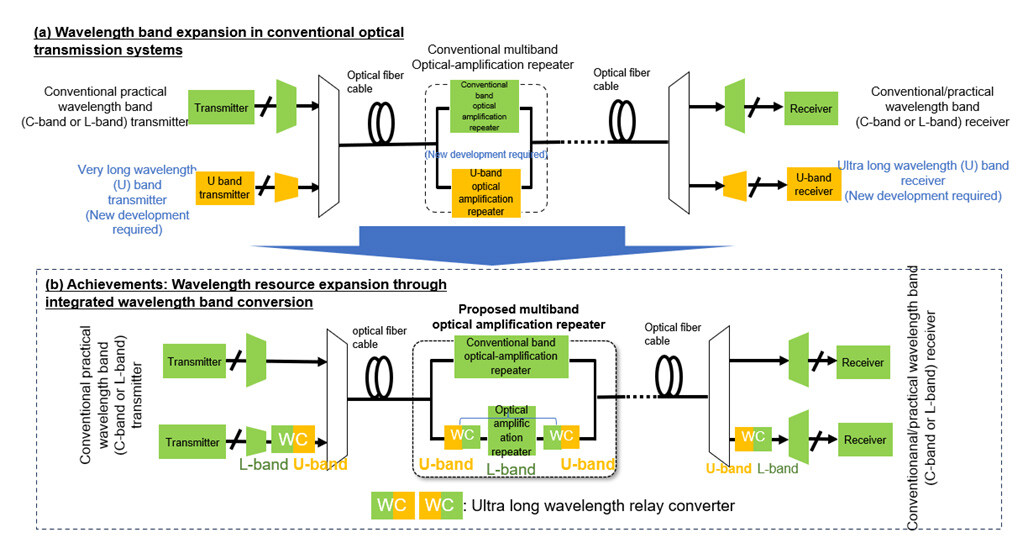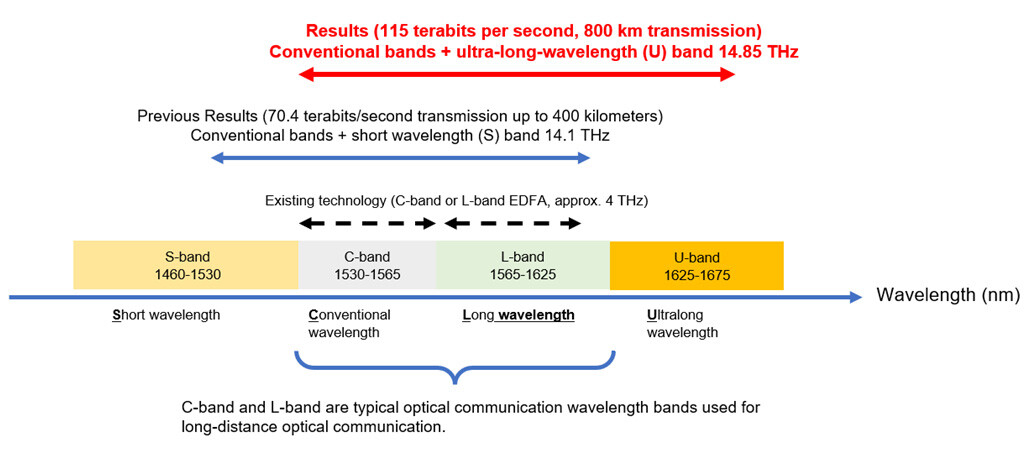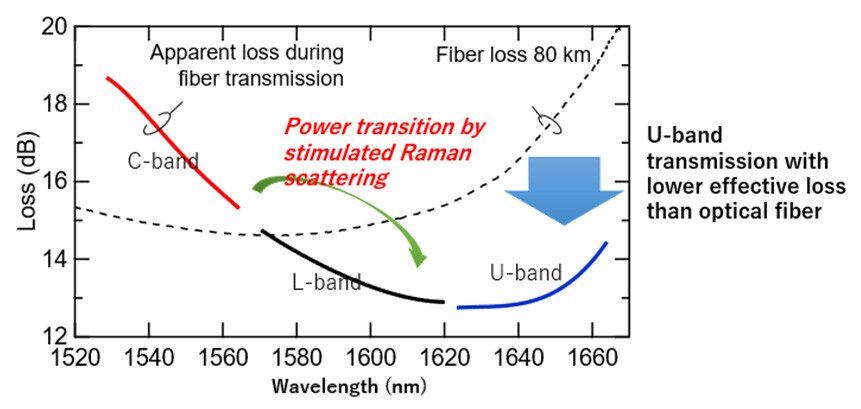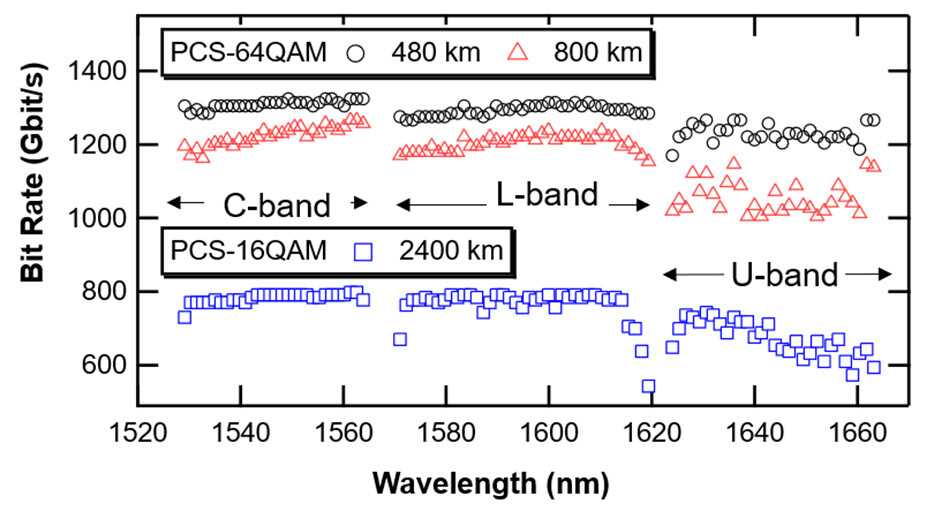Microsoft ends support for Internet Explorer on June 16, 2022.
We recommend using one of the browsers listed below.
- Microsoft Edge(Latest version)
- Mozilla Firefox(Latest version)
- Google Chrome(Latest version)
- Apple Safari(Latest version)
Please contact your browser provider for download and installation instructions.
September 3, 2024
NTT Corporation
World's first long-haul optical inline-amplified transmission over 100 Tbit/s capacity using ultra long-wavelength band conversion
Toward IOWN/6G, single-core optical fiber capacity more than three times larger than current technology
News Highlights:
- The newly developed periodically poled lithium niobate (PPLN) technology enables the use of new ultra-long wavelength by utilizing existing equipment.
- We have succeeded in extending the transmission bands distance, which has been a problem in developing technology to expand wavelength resources essential for increasing the capacity of optical transmission systems.
- These findings are expected to increase the capacity of each optical fiber core and increase the transmission distance.
TOKYO - September 3, 2024 - NTT Corporation (Headquarters: Chiyoda Ward, Tokyo; Representative Member of the Board and President: Akira Shimada; hereinafter "NTT") has succeeded for the first time in the world in achieving 800 km long-haul optical transmission with a capacity exceeding 100 Tbit/s by applying its newly developed wavelength band conversion technology using only a lumped optical amplifier over existing fiber while maintaining the same 80 km relay spacing (80 km) as in conventional land systems [1].
In a large-capacity optical transmission system, it is important to be able to amplify and transmit over a distance longer than the Tomei section (approx. 500 km), which is the main artery of the optical backbone network in Japan. In this experiment, we applied a newly developed wavelength band conversion technology for the ultra-long wavelength band (U-band)1 and demonstrated the world's first long-haul optical amplification relay transmission2. Applying the U-band to optical transmission systems using conventional technology requires the development of transceivers and optical amplifier repeaters (Figure 1 (a)), but this is difficult to achieve with existing materials. In this experiment, we realized U-band optical amplification relay by using conventional band equipment and devices using ultra-long-wavelength band conversion technology (Figure 1 (b)). In addition, by merging with existing optical amplification technology, the wavelength resources were expanded to 14.85 THz using the 3 wavelength bands of C-band, L-band, and U-band, and long-distance large-capacity optical-amplification relay transmission was realized.
This study shows the possibility of expanding wavelength resources to ultra-long wavelength bands in optical fiber communications, and is expected to be a basic technology that can deliver large-capacity data more than three times the existing data to further distances in the IOWN3/6G all-photonics network.
 Figure 1 Positioning of This Result and Expansion of Wavelength Resources through Combined Wavelength Band Conversion Technology
Figure 1 Positioning of This Result and Expansion of Wavelength Resources through Combined Wavelength Band Conversion Technology
1. Background
With the spread of applications that require high-speed communications and the rapid progress of AI, the amount of data traveling around the world is increasing significantly, and the optical network support is required to continuously increase the capacity. In optical fiber transmission systems used in optical backbone networks, a large number of digital coherent4 optical signals with different wavelengths are bundled, amplified and relayed as optical signals, and transmitted over optical fibers spread to the destination over a long distance. At present, optical amplifiers (EDFA) with an optical amplification band (= wavelength resource) of approximately 4 THz are used as repeaters, and optical bands called C-band or L-band are in practical use. By upgrading transceivers, we have been trying to increase the capacity of optical fiber transmission systems. However, increasing the capacity of the transceiver by itself is approaching the theoretical limit, and it is necessary to expand the bandwidth to new wavelength bands to further increasing the capacity. In addition, optical transmission systems are required to have larger capacity and longer distances, and it is important to be able to amplify and relay over a distance equal to or greater than that of the Tomei section (approx. 500 km), which is the largest transmission volume in Japan's optical backbone network.
NTT has been demonstrating broadband-amplification relay technology using optical parametric amplification5 using PPLN (Periodically Poled Lithium Niobate)6 waveguides to expand wavelength resources. Up to now, wavelength resources have been expanded to the short wavelength-side (S-band) of the C band, which is the conventional band, and the maximum transmission distance is 400 km (NTT release7) in the optical band of 14.1 THz. On the other hand, the expansion of wavelength resources to the ultra-long-wavelength band (U-band), which is adjacent to the L-band, another conventional band, has the problem that optical fiber loss is higher than that of the conventional band. In general, to use a new wavelength band for transmission, it is necessary to develop new transmission equipment such as a transceiver and an optical amplifier repeater for that band. However, it is difficult to realize U-band transmission equipment with the existing material systems. In this achievement, by applying ultra long-wavelength band conversion technology and utilizing conventional equipment and devices, we have expanded the wavelength band to 14.85 THz in total for three wavelength bands, two conventional wavelength bands (C-band and L-band) and a new ultra long-wavelength band conversion (U-band) (Figure 2). By applying high-precision transmission design technology, we have solved the problem and demonstrated large-capacity, long-haul transmission (Figure 1).
 Figure 2 Wavelength Band Expanded by This Achievement
Figure 2 Wavelength Band Expanded by This Achievement
2. Key points of the technology
(1) U-Band optical-amplification repeater applying wavelength band conversion technology
Currently, there are few optical equalizers and other devices compatible with the U-band, making it difficult to amplify and relay U-band Wavelength-Division-Multiplexed (WDM) signals as they are. In this research, we focused on wavelength band conversion, which is one of the functions of optical parametric amplification, and newly designed and fabricated a PPLN waveguide capable of wavelength band conversion between the L-band and the U-band, and implemented it as an integrated wavelength band converter. In addition, we have constructed a U-band optical-amplification relay with a hybrid configuration of this wavelength band converter and the existing L-band EDFA/optical equalizer (Figure 3). This repeater converts the U-band WDM signal to the L-band, equalizes the gain in the L-band, compensates for the loss with EDFA, and converts it back to the U-band, enabling high-quality U-band optical amplification relay with a bandwidth of 4.5 THz.
 Figure 3 Configuration of U-band Optical-Amplification Repeater Using Wavelength Band Conversion Technology
Figure 3 Configuration of U-band Optical-Amplification Repeater Using Wavelength Band Conversion Technology
(2) Wideband WDM transmission design technology
The U-band is generally a wavelength band where infrared absorption loss increases due to the bending loss of optical fiber and the characteristics of silica glass, the material of optical fiber. On the other hand, when a wideband WDM signal exceeding 10 THz is propagated over an optical fiber, a phenomenon called stimulated Raman scattering occurs, which causes a transition of optical power from the short wavelength-side to the long wavelength-side. Since stimulated Raman scattering varies in a complex manner depending on the optical signal power of each wavelength and the optical spectral shape of the wavelength multiplexed signal, it is difficult to investigate the optimum transmission conditions experimentally. NTT has independently improved a theoretical calculation model called the Gaussian noise model8 [2], calculated transmission conditions in consideration of experimental constraints to maximize the total transmission capacity of the three wavelength bands, and applied it to optical transmission experiments. This effectively reduces the loss in the U-band (Figure 4) by using the stimulated Raman scattering effect to shift the power from the conventional C-band and L-band signal light to the high-loss U-band signal, thereby enabling a high-precision transmission design that achieves both transmission capacity and long distance.
 Figure 4 Optical fiber loss and effective broadband transmission loss
Figure 4 Optical fiber loss and effective broadband transmission loss
(3) Ultrafast digital coherent signal transmission/reception technology
Polarization-multiplexed PCS-QAM signals9 with a symbol rate of 144 Gbaud10 are used as digital coherent signals for each wavelength. In this achievement, by applying digital signal processing technology [3] that maximizes circuit performance to high-speed circuit technology being researched and developed by NTT, the symbol rate has been increased by approximately 10% from the previous achievement7, and signals more suitable for long-distance transmission have been realized. High-speed multilevel optical signals from approximately 600 Gbit/s to a maximum of 1.3 Tbit/s per wavelength is possible, depending on the transmission distance (Figure 5).
 Figure 5 (a) 144 Gbaud Optical Signal Spectrum and (b) Constellation After Optical Fiber Transmission
Figure 5 (a) 144 Gbaud Optical Signal Spectrum and (b) Constellation After Optical Fiber Transmission
3. Outline of optical-amplification relay experiment
We constructed a re-circulating loop transmission experiment11 with a relay interval of 80 km and conducted optical-amplification relay transmission experiments in the 14.85 THz band. Assuming a WDM interval of 150 GHz, the C-band has 30 wavelength division multiplexing signals of 4.5 THz, the L-band has 39 wavelength division multiplexing signals of 5.85 THz, and the U-band has 30 WDM signals of 4.5 THz (Figure 6). WDM signals in the U band are generated by converting signals in the existing wavelength band. The total wavelength division multiplexed signal to be transmitted is 99 wavelengths and 14.85 THz, and the optical power and spectrum shape of each wavelength band are set based on wideband transmission design technology. The C-band and L-band optical amplifiers use optical amplifiers (EDFA) for their respective bands, and the U-band optical amplifiers use wavelength band conversion technology. We evaluated the signal quality of 144 Gbaud PCS-QAM signals at all wavelengths, and obtained a transmission capacity of 125.6 Tbit/s more than 1.7 times lager at a distance of 480 km, which is equivalent to the maximum transmission distance in the previous study7. In addition, at a transmission distance of 800 km, a transmission capacity of 115.3 Tbit/s was achieved with all wavelength channels of 1 Tbit/s or more. This is the longest transmission distance in the world over 100 Tbit/s at a relay interval of 80 km using only a lumped amplifier. We also achieved a capacity of 72.6 Tbit/s even after 2400 km transmission, demonstrating the possibility of expanding wavelength resources to the ultra-long wavelength band in long-haul optical transmission (Figure 7).
 Figure 6 Optical Spectrum of WDM Signals in Transmission Line I/O
Figure 6 Optical Spectrum of WDM Signals in Transmission Line I/O
 Figure 7 Results of 14.85 THz Band Long-Haul Optical-Amplification Relay Transmission Experiment
Figure 7 Results of 14.85 THz Band Long-Haul Optical-Amplification Relay Transmission Experiment
4. Outlook
The expansion of wavelength resources to the ultra-long wavelength-side achieved in this research, when used together with the wavelength resource expansion technology for the short wavelength-side, is expected to further increase the bandwidth beyond 20 THz and increase the capacity by expanding the wavelength resources flexibly suited to the characteristics of the optical fiber transmission line and the entire transmission system. Wavelength resource expansion technology will greatly expand the scalability of transmission capacity and distance by integrating high-speed optical transmission (multi-terabit) technology12 (Figure 8). NTT will continue to advance R&D by further integrating its proprietary device technology, digital signal processing technology, and optical transmission technology toward the evolution of all-photonics networks in the 2030s for IOWN/6G.
 Figure 8 Results and Outlook
Figure 8 Results and Outlook
Research support
Part of the results of this research were obtained through commissioned research (JPJ012368C04501) of National Institute of Information and Communications Technology (NICT).
[References]
1.Takayuki Kobayashi, Shimpei Shimizu, Akira Kawai, Masanori Nakamura, Masashi Abe, Takushi Kazama, Takeshi Umeki, Munehiko Nagatani, Kosuke Kimura, Hitoshi Wakita, Yuta Shiratori, Fukutaro Hamaoka, Hiroshi Yamazaki, Hiroyuki Takahashi, and Yutaka Miyamoto, "C+L+U-Band 14.85-THz WDM Transmission Over 80-km-Span G.654.E Fiber with Hybrid PPLN-OPA/EDFA U-Band Lumped Repeater Using 144-Gbaud PCS-QAM Signals," in Proc. OFC2024, paper Th4A.1, 2024.
2.Kosuke Kimura, Takayuki Kobayashi, Shimpei Shimizu, Masanori Nakamura, Takushi Kazama, Masashi Abe, Takeshi Umeki, Akira Kawai, Fukutaro Hamaoka, and Yutaka Miyamoto, "GN-model-based SNR estimation in 15.2-THz bandwidth inline-amplified transmission with 80-km fibre spans," in Proc. ECOC2023, paper We.C.2.3, 2023.
3.Akira Kawai, Masanori Nakamura, Takayuki Kobayashi, Munehiko Nagatani, Hiroshi Yamazaki, Takeo Sasai, Fukutaro Hamaoka, and Yutaka Miyamoto, "Digital Inverse Multiplexing for Transmitters With Symbol Rates Over DAC Bandwidth Limit," J. Lightwave Technol. 42, 4076-4085, 2024.
1.Wavelength band name and wavelength range
The C-band and L-band are typical optical communication wavelength bands used for long-haul optical communication as low-loss wavelengths of quartz optical fiber and have been internationally standardized by the International Telecommunication Union (ITU-T). The C (Conventional) band has a wavelength range of 1530 -1565 nm, and the L (Long wavelength) band has a wavelength range of 1565 -1625 nm. A practical optical amplification relay is possible for these two signal wavelengths. The signal bandwidth of C-band and L-band is approximately 4~5 THz when converted to the optical frequency bandwidth. The short wavelength side of the C-band, 1460 nm to 1530 nm, is called the S (Short wavelength) band, and the long wavelength side of the L-band, 1625 nm to 1675 nm, is called the U (Ultralong wavelength) band.
2.NTT survey as of July 2024.
3.IOWN
NTT news release: "NTT Technology Report for Smart World: What's IOWN?"
https://group.ntt/jp/newsrelease/2019/05/09/190509b.html
4.Digital coherent
Digital coherent technology is a highly efficient optical transmission method combined with digital signal processing and coherent reception. Coherent reception is a technology that can receive the amplitude and phase of light by interfering with the received optical signal with a light source placed on the receiving side. The frequency utilization efficiency is improved by modulation methods such as polarization multiplexing and phase modulation, and the highly accurate optical signal compensation using digital signal processing and coherent reception greatly improve reception sensitivity.
5.Optical parametric amplifier (OPA)
This technology amplifies light of a specific wavelength by making light of different wavelengths interact with each other using the nonlinear optical effect generated in a material. Highly nonlinear fibers and lithium niobate are known as nonlinear media.
6.Periodically poled lithium niobate (PPLN)
In lithium niobate (LiNbO3), which is a nonlinear medium, this is an artificial crystal in which the direction of positive and negative charges in the crystal, called spontaneous polarization, is forcibly reversed at a fixed period. PPLN can achieve significantly higher nonlinear optical effects than the original lithium niobate crystal.
7.NTT News release: "Achievement of long-haul optical-amplification relay in the world's largest 14.1 THz band"
https://group.ntt/jp/newsrelease/2023/06/16/230616c.html
8.Gaussian noise model
The noise added to the signal by optical amplifiers and electrical circuits is called Gaussian noise and is added to the amplitude of the signal (additivity), and the value has the statistical property of Gaussian distribution. On the other hand, optical signals are subject to distortion due to nonlinear optical effects on optical fibers. However, since the effect of distortion depends on the waveform of the signal, it is difficult to treat it in a unified manner with noise. In the Gaussian noise model, the nonlinear distortion is averaged by the effect of the wavelength dispersion of the optical fiber in long-haul transmission, and is treated as noise following a Gaussian distribution. Strictly speaking, the amount of signal distortion and noise cannot be added. However, the Gaussian noise model calculates and adds the factors that cause signal degradation as noise, enabling unified treatment and transmission design based only on the signal-to-noise ratio.
9.PCS-QAM signal
PCS (Probabilistic Constellation Shaping) is a technology that reduces the signal-to-noise ratio requirement for signal transmission by optimizing the distribution and placement of signal points based on information theory. QAM (Quadrature Amplitude Modulation) is a modulation method that applies information to both the amplitude and phase of the signal light. By applying PCS technology to the QAM system, the signal quality can be optimized according to the transmission line conditions. In this research, PCS-64QAM and PCS-16QAM are used as evaluation signals.
10.Gigabaud (Gbaud)
The number of times a light waveform is switched per second. The 144 gigabaud optical signal transmits information by switching the optical waveform 144 billion times per 1 second.
11.Circulating loop transmission experiment
An experimental system in which optical amplifiers and transmission line fibers are connected in a loop and the input/output timing of optical signals is controlled by an optical switch, enabling testing of long-haul optical transmission with a small number of equipment.
12.High-speed optical transmission (multi-terabit) technology
NTT news release: "NTT Achieves the World's Fastest Optical Transmission of over 2 Tbits/s Per Wavelength"
https://group.ntt/en/newsrelease/2022/09/22/220922a.html
About NTT
NTT contributes to a sustainable society through the power of innovation. We are a leading global technology company providing services to consumers and businesses as a mobile operator, infrastructure, networks, applications, and consulting provider. Our offerings include digital business consulting, managed application services, workplace and cloud solutions, data center and edge computing, all supported by our deep global industry expertise. We are over $97B in revenue and 330,000 employees, with $3.6B in annual R&D investments. Our operations span across 80+ countries and regions, allowing us to serve clients in over 190 of them. We serve over 75% of Fortune Global 100 companies, thousands of other enterprise and government clients and millions of consumers.
Media contact
NTT Science and Core Technology Laboratory Group
Public Relations
nttrd-pr@ml.ntt.com
Information is current as of the date of issue of the individual press release.
Please be advised that information may be outdated after that point.
NTT STORY
WEB media that thinks about the future with NTT










